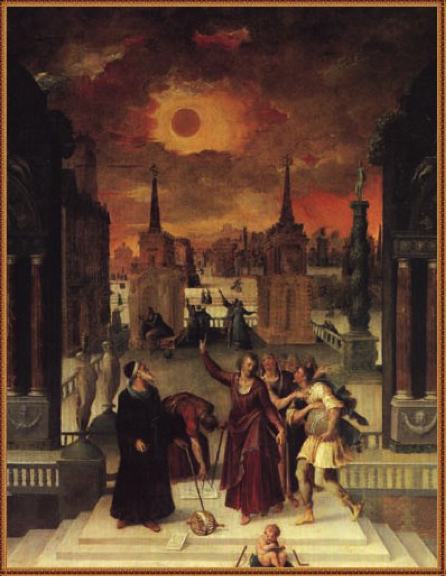Miguel Crespo
Summer is here and again sun, humidity, and mosquitos will relentlessly plague our days. But the firmament reserves something unique for us: a celestial spectacle we do not get to witness every day. On Monday August 21, 2017, a total solar eclipse will cast its shadow across America. For those who happen to be in the right place at the right time, a once in a lifetime experience will take place in the form of a couple of priceless minutes when the sky will switch colors like the canvas of a mad artist.
But what is a total solar eclipse anyway? A total solar eclipse occurs when the Moon stands between the Sun and the Earth, briefly obscuring a patch of land where night and day become indistinguishable for a few moments.
The ancient Chinese legend has it that solar eclipses occurred when a legendary celestial dragon devoured the Sun. In Vietnam, a frog eats the Sun, while people of the Kwakiutl tribe on the western coast of Canada are convinced that the mouth of heaven consumes the Sun. Myths and legends of the ancient world always had something romantic to them. As a child, I loved to believe them until one day I was pointed to a scientific source, only to learn from Stevie Wonder that “…when you believe in things that you don’t understand then you suffer, superstition ain’t the way.” Modern science has elucidated mythical representations of natural phenomena—the Hubble telescope taught us that red light comes from farther away than we thought, and yes, the Earth does revolve around the Sun. Times of darkness and ignorance are long gone for humanity. Or are they? A quick YouTube search is enough to come across countless videos proclaiming the wackiest ad hoc interpretations of this summer’s forthcoming eclipse. Fulfillments of biblical prophecies always come in handy, and contrary to the general opinion, never get old. However, Numerology is my all-time favorite. Desperate subtracting and adding in search of the just too probable coincidence, ideal for the construction of the pyramids by Martians but may also be invoked in case of an eclipse. Together with a few Web sites of the same genre, this serves as a reminder that, as Sam Harris said, “Civilization is still besieged by the armies of the preposterous.”
The majestic gift from Helios is as beautiful as it is ephemeral. Only two to five minutes in the path of totality guarantee the full-blown eclipse experience. The path of totality is a 70-mile-wide stretch of land that will diagonally run from Oregon, all the way down to South Carolina. In search of a reverse path of enlightenment, thousands of enthusiasts will travel to those areas, carefully mapped by NASA, where Selene and Helios will unite in the short-lived affair that the Ancient Greeks anticipated so many centuries ago. Hotel owners and tour organizers alike have also taken note of the event, offering the best rates to enjoy the unforgettable experience together with music festivals, river cruises or even a trip on horseback.
Anticipation has been building during the last few months. Currently, myriad Web sites offer relevant information, including the best spots to view the eclipse, the weather forecast, timing, eclipse simulations, and the exact dates of past and future eclipses. As a matter of curiosity, the longest eclipse will last seven minutes and twelve seconds, and will happen on June 25, 2522 for those who are still around. The best maps can be found on the NASA site www.eclipse2017.nasa.gov, while www.eclipse2017.org offers everything you always wanted to know about eclipses but were afraid to ask.
Some might wonder if those meager two minutes of glory are worth the travel, the wait and the expense. Well, here is what we can expect from a total solar eclipse. If you are within the path of totality, the so-called Contact 1 marks the beginning of the show. The Moon disk seems to tangentially come in contact with the Sun, biting a tiny little piece of its periphery. As it progresses further into the Moon, the Sun starts looking more and more like a crescent, the tables turn and it becomes “a little moon” for a moment. This image is priceless, though just as harmful as looking at the Sun at any other time: only special eclipse filters or glasses can be used to safely enjoy this moment. The good news is they are inexpensive and easy to find, remember: Google is your friend. As the Moon incessantly munches on the defenseless Sun, eclipse watchers will notice its shadow looming closer and closer. There is no way back; only a silver ring will be visible when the two celestial bodies finally join in this improbable turn of events. But there is more: from that point on the atmosphere becomes eerie, the air acquires a rare quality, the sky darkens, and birds start to chirp in bewilderment. As the temperature drops in the improvised night, the miracle finally occurs and the entire Sun is hidden behind the almighty Moon. Only then can one look at the Sun without protection, and only in these circumstances will one be able to see the Sun corona. An aura of plasma extends into the sky surrounding the Sun, like a pearly white crown emitting ever-changing rays. The glow of a multitude of mutating colors in a shimmering cotton candy around an impossibly black hole. No photo, no National Geographic documentary would do justice to the uniqueness and the magic of witnessing a total solar eclipse.

